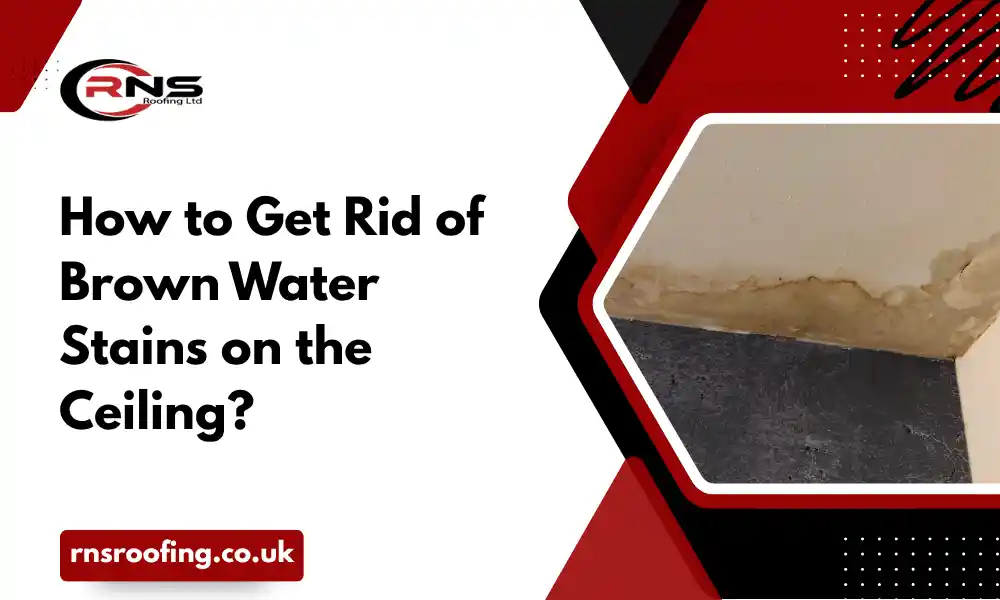Brown stains on your ceiling are a common problem, and they’re usually a sign of a leak from the roof, pipes, or even condensation in the attic. These stains not only look bad but can also lead to mould, peeling paint, and long-term damage if left untreated.
If you’re wondering how to get rid of brown water stains on ceiling, this guide walks you through the causes, cleaning methods, and simple ways to prevent them from coming back. With the proper steps, you can restore your ceiling and avoid future problems.
What Causes Brown Spots on the Ceiling?
Both new and old homes can experience ceiling stains from water. There are various causes, from leaky pipes to roof problems. Regardless of size, these brown water spots indicate underlying issues that, if ignored, can lead to bubbling, cracking, and further damage.
You might notice a small brown ceiling stain and think it’s just a natural result of age. However, these stains usually indicate that water is getting in. Let’s explore the possible reasons behind the brown spots so you can understand the problem and how to fix it.
Sometimes a small brown spot on the ceiling is easy to ignore, but it’s usually a sign that water is getting in. Roof damage is a common reason behind this. You can learn more about the common causes of roof leaks to understand better where the water might be coming from.
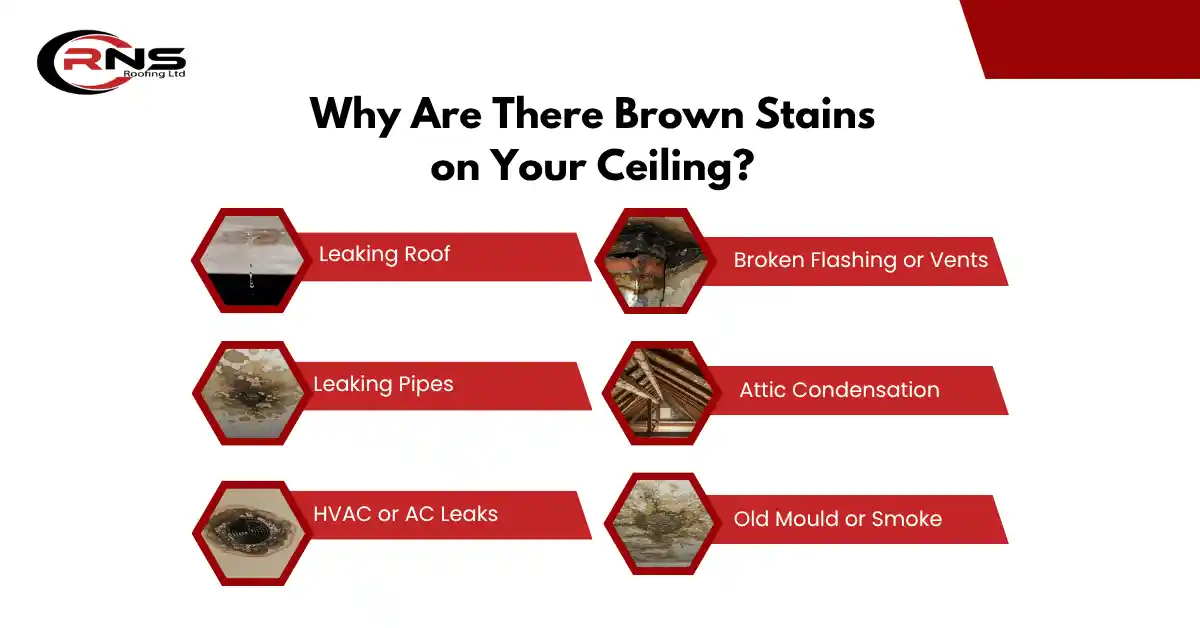
1. Leaking Roof
Missing shingles, damaged flashing, or clogged gutters can allow water to enter. That water can drip down and leave brown spots on the ceiling.
2. Broken Flashing or Vents
Roof flashing around vents, chimneys, or skylights can fail over time. When this happens, water gets in around the edges and causes ceiling water stains.
3. Leaking Pipes
If your bathroom or plumbing lines run above the ceiling, a small leak can leave a brown water stain on the ceiling over time.
4. Attic Condensation
Warm indoor air can rise and hit a cold attic space. That creates condensation, which drips down and shows as water marks on the ceiling.
5. HVAC or AC Leaks
A faulty HVAC unit can leak into the ceiling below. If you see brown water leaking from the ceiling, turn off your unit and call a professional.
6. Old Mould or Smoke
Sometimes, what appears to be a water stain on the ceiling could be old smoke damage or mould from poor ventilation.
How to Clean Brown Water Stains on the Ceiling
When dealing with water stains on the ceiling, always prioritise safety. Wear protective equipment, such as gloves and safety goggles, and gather the necessary materials, including vinegar, bleach, a sponge or cloth, and a ladder if applicable.
There are four methods for cleaning brown stains. Choose according to your preference and the severity of the damage:
1. Vinegar & Water
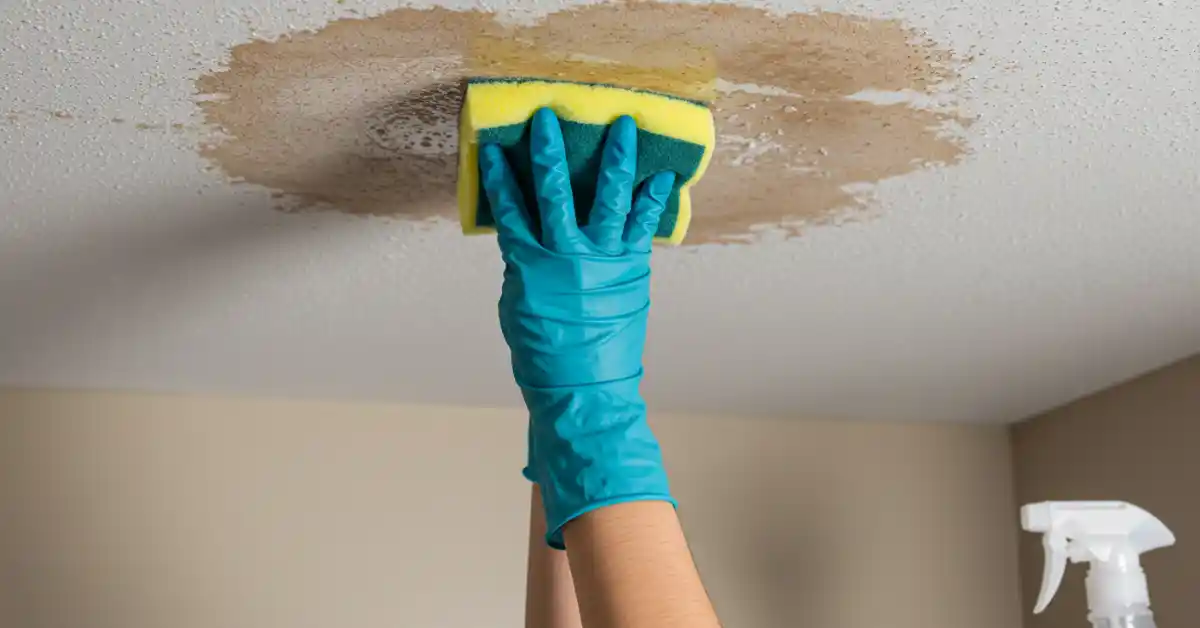
- Mix half vinegar and half warm water
- Dab the stain gently with a sponge
- Wipe off after 10 minutes
2. Baking Soda Paste
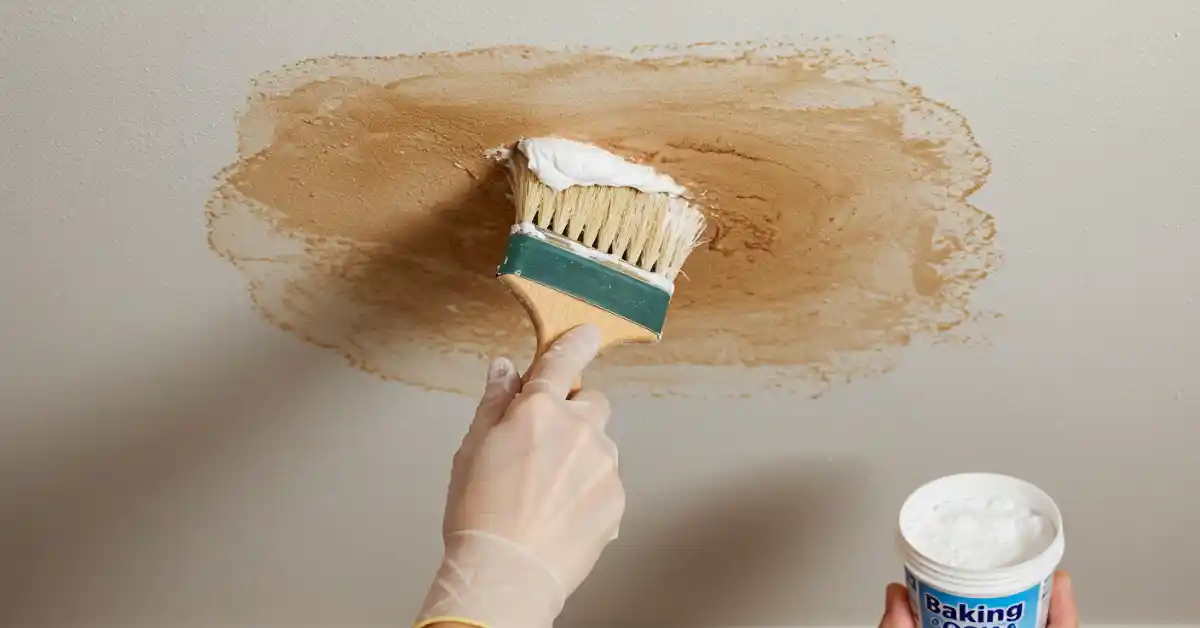
- Mix baking soda and water into a thick paste
- Apply the stain
- Let it sit for 15 minutes, then scrub gently
3. Bleach Solution
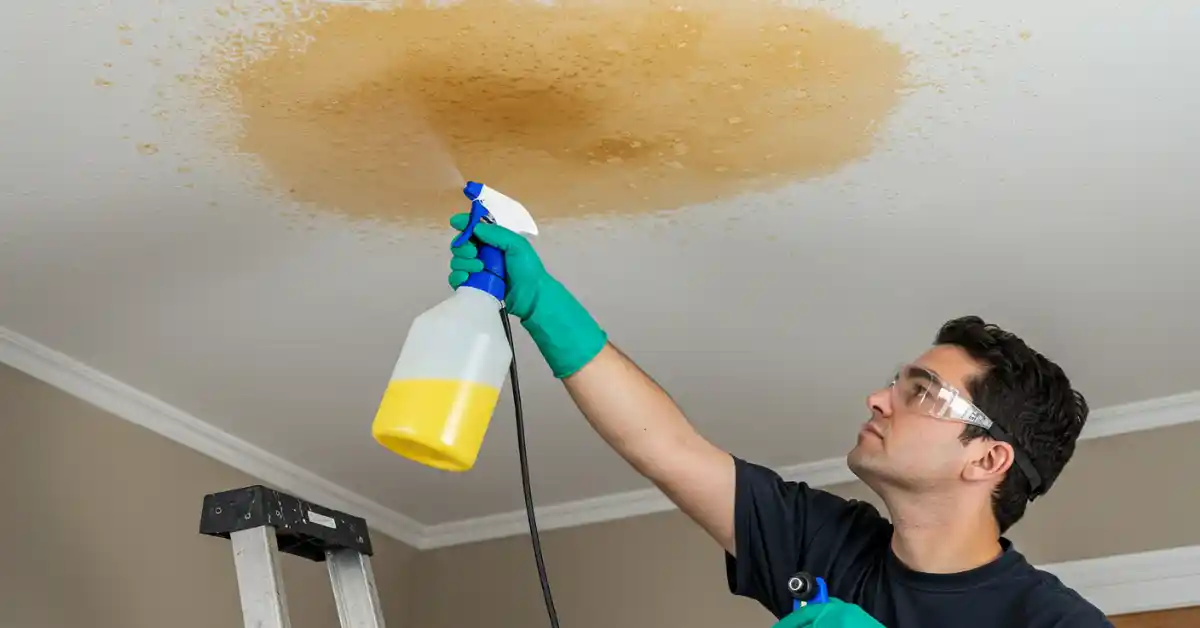
- Mix 1 part bleach with three parts water
- Spray onto the stain (wear gloves and goggles)
- Let it sit, then wipe clean
4. Commercial Stain Remover
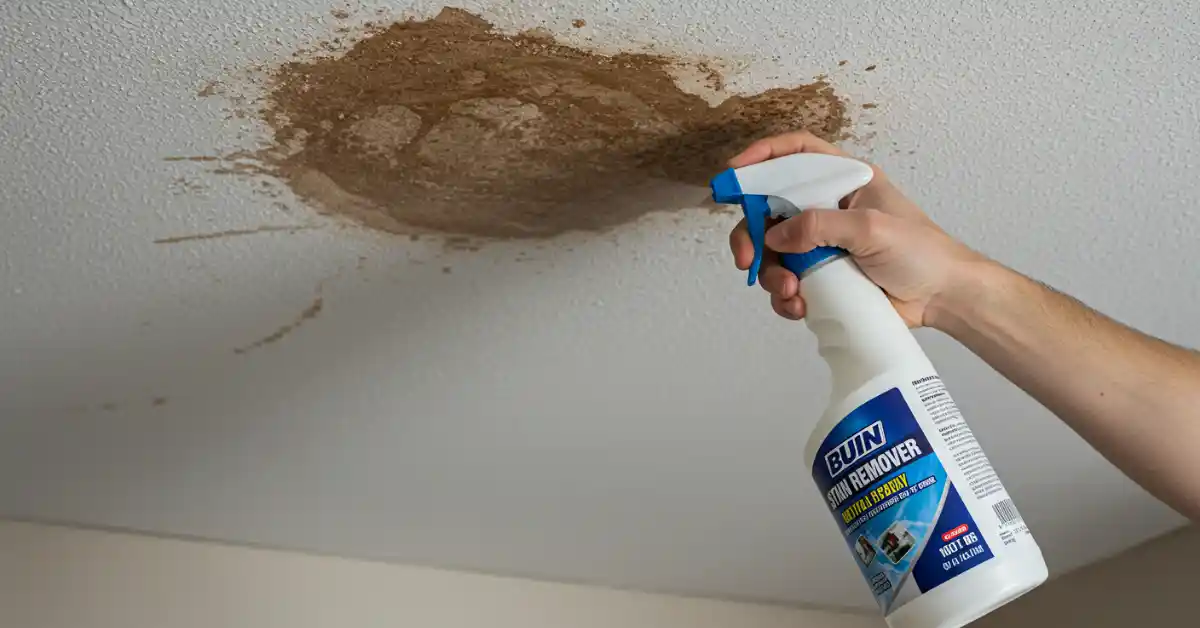
Several commercial stain removers are available on the market. Use a cleaner designed to cover watermarks on ceiling. Follow the instructions on the product label and apply to the affected areas as recommended.
- Solution Preparation: Follow the directions to mix the chosen cleaning solution.
- Application on the Stains: Spray or apply the solution onto the brown water stains on the ceiling.
- Scrubbing: Using a sponge or cloth, gently scrub the stains to release dirt and dust.
- Rinsing: Rinse the ceiling with clean water and dry it thoroughly before evaluating the results.
How to Cover Up Water Stains on a Ceiling (After Cleaning)
If the stain is still visible after cleaning, here’s how to cover it up:
- Let the ceiling dry fully
- Use a stain-blocking primer on the spot
- Paint over it with ceiling paint
Make sure your ceiling is dry before painting. If it’s still damp, the brown stain on the ceiling may come back.
Common Prevention Tips:
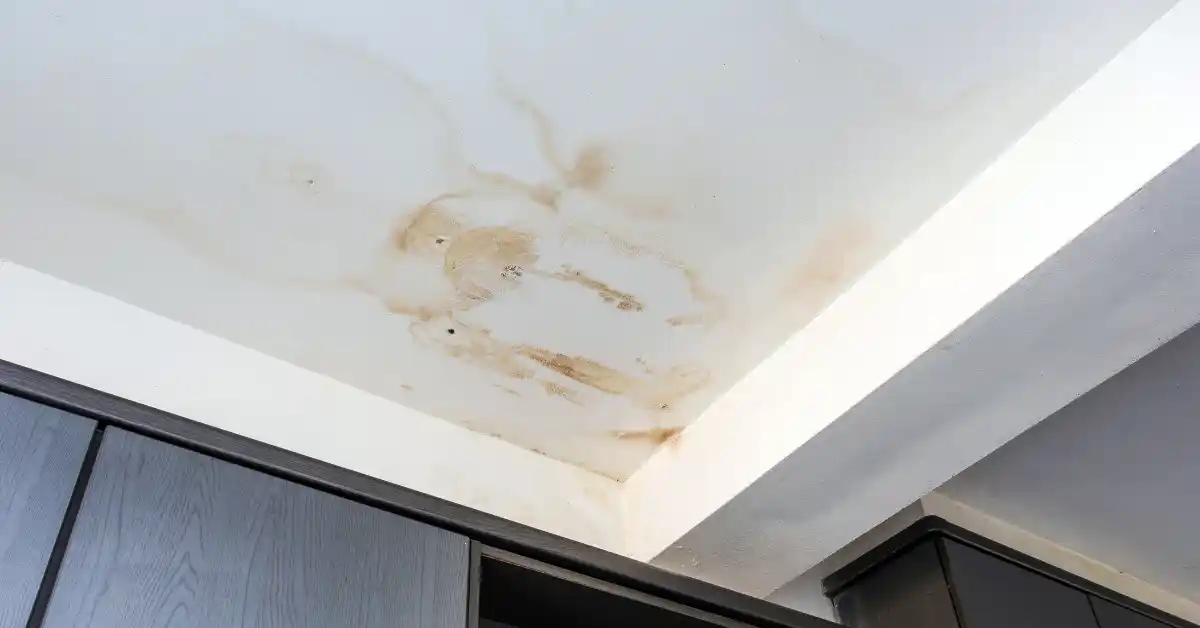
- Fix leaks: To avoid water damage, address any leaks you find right away. Verify the water pipelines and supply lines. If there’s a more serious issue, you can contact Roofers in Guildford for fast and reliable service.
- Maintain gutters and downspouts: clogged gutters allow water to overflow, which can cause ceiling-destroying roof leaks.
- Improve ventilation: Proper ventilation is essential in high-humidity areas, such as kitchens and bathrooms. Maintain the humidity between 30% and 50% by using a hygrometer.
- Use your bathroom exhaust fan: Condensation accumulation during showers will be avoided by using the exhaust fan.
- Use moisture-resistant drywall in the bathroom: Mould, mildew, and brown water stains are less common in drywall that is resistant to moisture.
- Seal cracks and use water-resistant paint: Water-resistant paint repels water and stops stains, while proper sealing shields your ceiling from water intrusion.
Conclusion:
Brown water stains on ceilings are a common problem, but with the proper steps, they’re easy to clean and cover up. Just make sure to fix the leak before anything else. A little cleaning, priming, and painting can make a big difference. If the stains keep coming back or the damage looks serious, it’s best to call a professional roofer or water damage expert. You can preserve the clean, smooth look of your ceiling for many years to come with the right maintenance and care.
FAQs
Can brown water spots on the ceiling cause health problems?
If left untreated, brown water stains on ceilings have the potential to cause health issues because they encourage the growth of mould and mildew. Airborne mould spores can worsen respiratory conditions, including asthma and allergies. Water stains must be removed right away to stop mould from growing and preserve the purity of the air within.
How much does it cost to repair brown water stains on the ceiling?
Depending on the degree of damage, the underlying reason for the stains, and the required repairs, brown water stains on the ceiling may cost different amounts to repair. It’s best to obtain quotes from skilled experts to determine the specific cost of repairs in your particular case.
What if brown water is leaking from the ceiling?
Please stop using the room and turn off the water and HVAC. That usually means an active leak. Call a plumber or roofer right away.
Can I paint over water stains?
Not directly. Always clean the stain and use a primer first. If you skip this step, the brown water stain on the ceiling will likely reappear.

